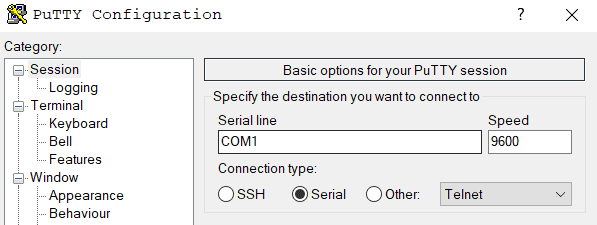Every Cisco router or switch has a single console port that is used to connect it to a computer directly for configuration and management. A console cable or a rollover cable is used to connect to the router or switch console port and is typically used during initial configuration as there is no network connection and remote access, such as Telnet, SSH, or HTTPS, configured on the device yet.
A terminal emulation software, such as Putty, is also needed to connect to the device. It is used so that we can use a PC or a laptop as a display device for the router or switch and have access to the device’s Command Line Interface (CLI). The software is essential as we need them to be able to configure devices initially and to be able to install routers and switches onto the network and enable remote management. You should connect your device via the COM port on your computer. You can check your COM port via the device manager.
Console Cable
The rollover cable is an RJ45 on one end and a DB9 on the other. It is the most popular console cable for older devices. You can still use it, but you’ll need an adapter if you don’t have a serial port on your device. Usually, you’ll use a DB9 to USB adapter to connect to your PC or laptop. Nowadays, there’s a direct RJ45 to USB console cable available in the market. Newer Cisco devices, usually the smaller and portable ones, have mini USB console ports. The console cable for it has a mini USB for the console port and a USB on the other end.
Console Port Configuration
With the console port, administrators can access the terminal lines of the Cisco devices’ IOS. However, this can be a potential threat in our networks because anyone can access the device freely, or a user can access the device by using the same password locally stored on the device. There is no authentication for the users.
A router or switch has one console port only. The console port has a line number of 0, thus ‘line console 0’. To secure the console port connections to our networking device, we can set a password by issuing the following commands below. In this way, we can secure our console port by requiring a password upon logging in.
Router(config)#line console 0 Router(config-line)#password StudyCCNA Router(config-line)#login
The management port is used for remote access only. The console port is used for local and physical access.
Download our Free CCNA Study Guide PDF for complete notes on all the CCNA 200-301 exam topics in one book.
We recommend the Cisco CCNA Gold Bootcamp as your main CCNA training course. It’s the highest rated Cisco course online with an average rating of 4.8 from over 30,000 public reviews and is the gold standard in CCNA training:
